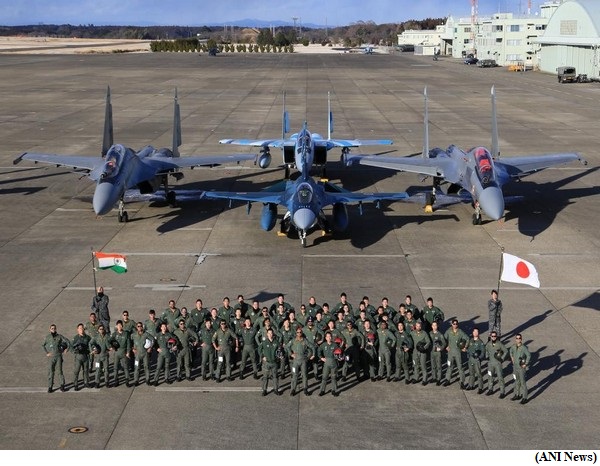IAF Joint Air Defence Exercise with Japan Veer Guardian 2023 Concludes (GS Paper 3, Defence)

Why in news
- The inaugural edition of the bilateral air exercise 'Veer Guardian 2023' between the Indian Air Force (IAF) and Japan Air Self Defence Force (JASDF) concluded in Japan recently.
Background
- The two countries agreed to step up bilateral defence cooperation and engage in more military exercises during the second 2+2 Foreign and Defence Ministerial meeting held in Tokyo on September 8, 2022
Key Highlights
- The JASDF participated in the exercise with its F-2 and F-15 aircraft, while the IAF contingent participated with the Su-30 MKI aircraft.
- The IAF fighter contingent was complemented by one IL-78 Flight Refueling Aircraft and two C-17 Globemaster strategic airlift transport aircraft.
- During the joint training spanning 16 days, the two Air Forces engaged in complex and comprehensive aerial manoeuvres in multiple simulated operational scenarios. The exercise involved precise planning and skillful execution by both the air forces.
- IAF and JASDF engaged in air combat manoeuvring, interception and air defence missions, both in Visual and Beyond Visual Range settings. Aircrew of the two participating Air Forces also flew in each other's fighter aircraft to gain a deeper understanding of each other's operating philosophies.
Way Forward
- Exercise ‘Veer Guardian 2023’ provided the two Air Forces with an opportunity to enhance mutual understanding.
- This enabled the participating contingents to obtain an invaluable insight into each other's best practices and learn from each other’s unique capabilities.
Inter Governmental Agreement to re introduce Cheetah to India from South Africa
(GS Paper 3, Environment)
Why in news
- Recently, South Africa and India have signed a Memorandum of Understanding on Cooperation in the Re-introduction of Cheetah to the Asian country.

Key Highlights
- The Memorandum of Understanding (MoU) on Reintroduction of Cheetah to India facilitates cooperation between the parties to establish a viable and secure cheetah population in India; promotes conservation and ensures that expertise is shared and exchanged, and capacity built, to promote cheetah conservation.
- This includes human-wildlife conflict resolution, capture and translocation of wildlife and community participation in conservation in the two countries.
- In terms of the MoU, the countries will collaborate and exchange best practices in large carnivore conservation through the transfer of technology, training of professionals in management, policy, and science, and to establish a bilateral custodianship arrangement for cheetah translocated between the two countries.
- The terms of the MoU will be reviewed every five years to ensure it remains relevant.
Why cheetah to be restored
- Restoring cheetah populations is considered to be a priority for India and will have vital and far-reaching conservation consequences, which would aim to achieve a number of ecological objectives, including re- establishing the function role of cheetah within their historical range in India and improving the enhancing the livelihood options and economies of the local communities.
- Following the import of the 12 cheetah in February, the plan is to translocate a further 12 annually for the next eight to 10 years.
- The initiative to reintroduce cheetah to a former range state following the local extinction of this iconic species due to over hunting and loss of habitat in the last century is being carried out following the request received from the government of the Republic of India.
Way Forward
- In terms of the agreement, an initial batch of 12 cheetahs are to be flown from South Africa to India during February 2023. The cats will join eight cheetah introduced to India from Namibia during 2022.
Govt notifies grievances appellate committees to look into complaints against social media firms
(GS Paper 2, Governance)
Why in news
- The Centre recently notified three grievances appellate committees that will address users' complaints against social media and other internet-based platforms.
- The notification is part of the tighter IT rules, notified in October 2022 for setting up government-appointed GACs.

Details
- The objective of establishing the GACs is to settle the issues that users may have against the manner in which social media platforms initially addressed their complaints regarding content and other matters.
- Each of the three GACs (grievances appellate committees) will have a chairperson, two whole-time members from different government entities and retired senior executives from the industry for a term of three years from the date of assumption of office.
First panel
- The first panel will be chaired by the chief executive officer of the Indian Cyber Crime Coordination Centre under the Ministry of Home Affairs.
- Retired Indian Police Service (IPS) officer Ashutosh Shukla and Punjab National Bank's (PNB) former chief general manager and chief information officer Sunil Soni have been appointed as the whole-time members of the panel.
Second panel
- The second panel will be chaired by the joint secretary in charge of the Policy and Administration Division in the Ministry of Information and Broadcasting.
- Indian Navy's retired Commodore Sunil Kumar Gupta and Kavindra Sharma, former vice-president (consulting), L&T Infotech, have been appointed as the whole-time members of this panel.
Third panel
- The third panel will be chaired by Kavita Bhatia, a senior scientist at the Ministry of Electronics and Information Technology.
- Former traffic service officer of the Indian Railways Sanjay Goel and former managing director and chief executive officer of IDBI Intech Krishnagiri Ragothamarao have been appointed as the whole-time members of the third panel.
Way Forward
- The provision of safe harbour under IT laws gives internet platforms; social media, e-commerce etc. protection from the content posted by users.




